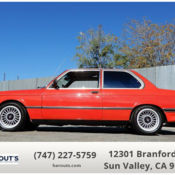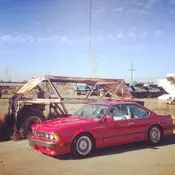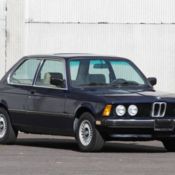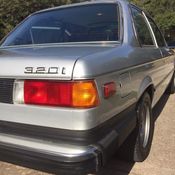BMW 320i WITH ORIGINAL ZENDER BODY KIT
| Make: | BMW |
| Model: | 3-Series |
| Type: | Coupe |
| Trim: | 320i |
| Year: | 1980 |
| Mileage: | 100,000 |
| Color: | Blue |
| Fuel: | Gasoline |
| Transmission: | Manual |
| Drive type: | Rear |
| Interior color: | Blue |
| Vehicle Title: | Clear |
| Item location: | Etobicoke, Ontario, Canada |
| Extras |
|
Leather Seats |
| Listed by | Private seller |
Description of 1980 BMW 3-Series |
| This spectacularly pristine 1980 320i looks to be only a few years old rather then 35 years! This car has always been stored indoors. Was originally silver but painted blue in the early 80's and the paint still looks perfect!!! This car has never had any rust!If you want the best 320i money can buy. this is it! No restoration required nor has it ever had one. It has been treated well since new and it shows. Call me anytime for more information David 416-802-9999It wears the ORIGINAL Zender Body Kit that was only available in the 1980's for a mere $3000 (huge money at the time)- Bumper- Wing- Rockers- Spoiler- 15 Inch MiM Wheels- Ansa Exhaust- Spacrco Race Seat- OMP Steering Wheel"A sedan that wasn't boring. A sporty car that normal people could fit in. A four-cylinder engine that stormed. The BMW 2002 embodied a number of items that had previously been contradictions. and was a hard act to follow. Yet BMW needed to: The 2002. designed in the days before our nation's new bumper. emissions and safety legislation. was getting long in the tooth. At the same time. the company needed to be smart enough to not discard the sporting feel that brought them to the dance of big-time American sales and exposure. The new car. the so-called E21 generation. launched in Europe in May 1975. but didn't make it to the States until the 1977 model year. The 320i's wheelbase was 21/2 inches longer than the 2002's. for a smoother ride. yet its overall length was just an inch-and-a-half longer. The basics established in the earlier car remained--MacPherson strut front suspension. rack-and-pinion steering. fully independent trailing-arm rear suspension. even the same two-liter engine was used initially--but the package looked and felt just a little more upmarket at the same time. European buyers had a choice of 1. 6-. 1. 8- and 2. 0-liter power. but America got only one engine at a time. Initially. the 320i's engine was a fuel-injected version of the same 2. 0L four that had powered the 2002 series for years. The fuel-injection system. the mechanical Bosch K-Jetronic system. is a continuous-injection system. rather than a pulsed system; it put out 110 horsepower (105 in California). 112-lbs. ft. of torque. and ran so cleanly that it didn't require a catalytic converter. (Early 320i models made do with a thermal reactor underhood instead. incinerating hydrocarbons. ) A four-speed Getrag gearbox was standard issue. although a three-speed ZF automatic was also available. The only E21 body style was a two-door sedan--there was no four-door 3-series until the E30 of 1983--and designer Paul Bracq transferred and updated a variety of styling cues--the forward-leaning twin-kidney grille. lack of extraneous adornment. the airy. upright greenhouse and the legendary Hofmeister Kink C-pillar among them; it was cut from the same jib as the 2002 and the new 528i. Its name followed BMW's new alphanumeric nomenclature approach. starting in the U. S. with the 5-series in 1975: series (3). engine displacement (20. meaning a two-liter). and a lowercase "i" denoting fuel injection. The interior also saw an evolutionary approach to the 2002's success; the longer wheelbase allowed both head and legroom to improve (aided also by cloth or vinyl seats that offered adjustable headrests and a variable-angle seat-back) and the white-on-black speedometer and tach remained front and center in the instrument cluster. The shifter remained on the floor. whether stick or automatic. However. the rest of the dash was molded to be angled toward the driver. making the HVAC controls easier to reach. (Air conditioning was included for the demanding American market; this necessitated that the radio be mounted vertically in order to accommodate the A/C unit in the console. )All of this came at a weight penalty: 3-series BMWs added roughly 250 pounds. depending on model and options. which also exacted a performance penalty. (They also started at $7. 90--not cheap for a car that didn't come standard with a radio or air conditioning. ) Yet. did the follow-up 3-series fall on its face? Hardly. As it turned out. the 320i was exactly the right car for its time. The notion of a small car suddenly made a lot more sense in those post-OPEC days. and while it wasn't the car that launched BMW in this country. it did become the official machine of young. upwardly-mobile professionals--or "yuppies. as they came to be known. Media reaction was positive in America. but not everywhere. "BMW have gone out of their way. almost to the point of introversion. to make the 320 as conservative as it possibly can be. gone is the rakishness to which the 2002 aspired. lamented U. K. title CAR. "Indeed. the handling and roadholding are of a high order. striking a sensible compromise between comfort and ultimate driver appeal. It is. in all ways. an efficient saloon. yet there is something about the 320 that's disappointing. perhaps the best way to explain it is by saying that the vehicle is clinically efficient. organized. planned. another step closer to the faultless saloon. But it's a dull car to drive. "Car and Driver. on the other hand. couldn't have gushed more effusively: "To begin with. it's a splendid little car. started their December 1976 review. ". the whole thing reeks of understated. wedge-shaped go-fast. the vinyl interior is just about perfect. the rear seats are roomy and comfortable. the absence of features like a radio or air-conditioning or power steering is never noticed. It's surprising how inconsequential such things become when you're in a car that works. it's beautifully engineered and not boring. "At first blush. you'd think that the 320i remained the same all its life. but this is not the case: Model year 1980 saw some invisible evolution take place under the skin. First. the engine dropped to 1. 8 liters (though the 320i moniker remained). and now used a three-way catalyst and Lambda sensor to monitor the air-fuel mixture to make 100 relatively green horsepower. A five-speed Getrag gearbox with . 81 overdrive replaced the four-speed. the 3. 64 rear was chucked out in favor of a 3. 91 rear on the five-speeds (3. 64 remained on automatics). Even so. the performance difference wasn't that noticeable: Thanks to the new rear gearing. a higher redline (6. 00 RPM vs. 6. 00 RPM) and a weight drop of 150-plus pounds. Car and Driver was able to get their 1980 model to 60 MPH and through the quarter-mile tenths faster than their 1977 model. Other differences included changing the side-view mirror from a pedestal-mount to an A-pillar-mount and a new instrument panel that better integrated the radio and air conditioning. Base price rose to $11. 65. In 1981. the 320iS ("S" for "sport") launched; this limited-run model featured the same 1. 8L driveline as the standard 320i and the same power output. but added limited-slip differential. Recaro seats. a more sporting suspension featuring a thicker front anti-roll bar and a rear anti-roll bar. leather-wrapped steering wheel and shift knob. a special air dam. special cross-lace alloy wheels. an AM/FM cassette deck. dual-operation manual sunroof. fog lamps and a deluxe tool kit. Roughly 2. 00 were built. The 3-series was an unqualified success for BMW: The millionth 3-series came off the line in May 1981. just half a dozen years after production commenced. Total worldwide sales topped 1. 36 million by the end of E21 production in mid-1982. and low-level versions were produced for European consumption through the mid-'80s. Certainly. the 3-series aided and vastly expanded BMW's sales in America: every year the 320i was on sale here. BMW posted a sales increase over the year before. and in fact the marque's U. S. sales numbers had more than doubled (to over 59. 00) in the time the 320i arrived and passed. Between healthy sales numbers and BMW Mobile Tradition. which through dealers offers virtually every part for every classic BMW ever. you should never want for parts. or parts cars. Yet the original 3-series is something of a forgotten commodity: It lies between the cult-favorite 2002 and the my-God-they're-still-everywhere E30 generation. Book values put the 320i at $5. 00 tops. although perfect and premium low-mileage examples will of course command more; we've seen cars like our feature car top $10. 00. Even so. this makes getting parts from the dealer a little on the expensive side. This 1980 example is owned by Brian Kumamoto of Irvine. California; the only options on his car are the sunroof. alloy wheels and fog lamps. which brought the sticker price to $14. 00. BodyThe good news is that with 1. 3 million examples built. with no significant facelift through the E21's life. and with support like BMW Mobile Tradition. body and trim pieces aren't difficult to find. However. buyers are cautioned to watch the floorpans. sills. shock towers. inner wheel wells and front fenders for rot. as these are the most susceptible areas. Also. telltale signs of a rough life can be seen via cracks on and around the B-pillars. Keep in mind that smaller. lighter European-type bumpers should easily bolt into place if you want to ditch the NHTSA-mandated battering rams. InteriorAll of the fiddly bits from door handles to dome-light covers are made and offered either by BMW Mobile Tradition or else by the aftermarket; as such. there isn't anything that's impossible to find. There are. however. things that are easier to replace than others. Those sculpted instrument panels are prone to crack. especially with all that glass area letting sun into the cabin. Air conditioning units can force some curious-looking stereo installations; neither A/C nor radios were standard-issue in the 320i. and A/C in particular was wanted more in the U. S. than in Europe. so watch for botched and sloppy aftermarket radio installations. EngineThrough 1979. BMW used a 2. 0L four that shared a lot with the 2002. which dated back to the '60s; in 1980. for emissions reasons. BMW swapped in a 1. 8L engine but kept the 320i designation. Both are chain-driven SOHC fours with an iron block and aluminum head. Two-liter cars use thermal reactors for emissions control; they crack fairly easily. and many owners will have discarded them. They're $500 or more to replace. (Later E21s used a catalytic converter. ) Head gaskets are a weak point. overheating can warp the head. and noisy cam chains are often fixed simply by changing the tensioner. TransmissionThe standard manual trans in any 320i is a fully synchronized Getrag unit: a model 242/18 four-speed in the 1970s models. and a model 245/2 5-speed with . 81 overdrive in the '80s E21s. Other than clutch judder. caused by poor installation or overheating. the Getrag boxes are slick-shifting. reliable and reasonably easy to get parts for. The automatic transmission used throughout the 320i's life was a ZF-built three-speed. and with regular fluid and filter changes. it shouldn't give any trouble. Brakes and SuspensionThe suspension basics date back to the 2002; although there are no carryover pieces. the basic layout is sound. If you hear a knocking sound on your test drive. it could be a worn upper strut bearing. Also. if the car vibrates while driving and/or braking. check the rubber sway bar and suspension bushings. We're also told that the front ends of these cars will shimmy at around 60 MPH as a matter of course--it goes away at higher speeds. All the more reason to drive one quickly! Also. the handbrake has been known to seize if it's left on for a long period of time. SpecificationsENGINE (1980-'83)Type: SOHC inline-four. iron block and aluminum headDisplacement: 1. 66ccBore x stroke: 89mm x 71mmCompression ratio: 8. 81:1Horsepower @ RPM: 101 @ 5. 00 RPMTorque @ RPM: 100 @ 4. 00 RPMMain bearings: 5Fuel system: Bosch K-Jetronic mechanical fuel injectionTRANSMISSIONType: Getrag 245/2 five-speed manual transmission. fully synchronizedSTEERINGType: Rack-and-pinionBRAKESType: Hydraulic. vacuum-assistFront: 10. 0-inch discRear: 9. 8-inch drumWEIGHTS AND MEASURESWheelbase: 100. 9 inchesOverall length: 177. 5 inchesOverall width: 63. 4 inchesOverall height: 54. 3 inchesCurb weight: 2. 35 poundsPERFORMANCE0-60: 9. 8 seconds1/4-mile: 17. 1 seconds @ 79 MPHTop speed: 105 MPH" |
 Home
Home Contact us
Contact us NEWEST CARS
NEWEST CARS SELL YOUR CAR
SELL YOUR CAR FAQ
FAQ







